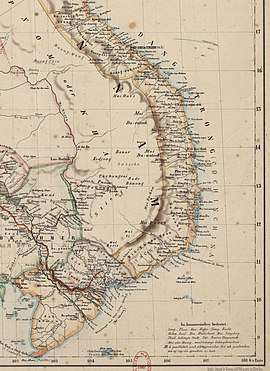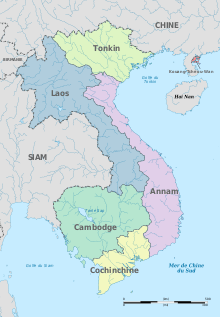Cochinchina
Cochinchina (/ˈkoʊtʃɪnˌtʃaɪnə/; Vietnamese: Miền Nam; Khmer: កូសាំងស៊ីន, romanized: Kausangsin; French: Cochinchine) is a historical exonym for part of Vietnam, depending on the contexts. Sometimes it referred to the whole of Vietnam, but it was commonly used to refer to the region south of the Gianh River.

In the 17th and 18th centuries, Vietnam was divided between the Trịnh lords to the north and the Nguyễn lords to the south. The two domains bordered each other on the Son–Gianh River. The northern section was called Tonkin by Europeans, and the southern part, Đàng Trong, was called Cochinchina by most Europeans and Quinam by the Dutch.[1]
Lower Cochinchina (Basse-Cochinchine) or Southern Vietnam, whose principal city is Saigon, is the newest territory of the Vietnamese people in the movement of Nam tiến (Southward expansion). This region was also the first part of Vietnam to be colonized by the French. Inaugurated as the French Cochinchina in 1862, this colonial administrative unit reached its full extent from 1867 and was a constituent territory of French Indochina from 1887 until early 1945. So during the French colonial period, the label "Cochinchina" moved further south, and came to refer exclusively to the southernmost part of Vietnam, once under the influence of Cambodia. Beside the French colony of Cochinchina, the two other parts of Vietnam at the time were the French protectorates of Annam (Central Vietnam) and Tonkin (Northern Vietnam). South Vietnam (also called Nam Việt) was reorganized from the State of Vietnam after the Geneva Conference in 1954 by combining Lower Cochinchina with the southern part of Annam, the former protectorate.
Background
The conquest of the south of present-day Vietnam was a long process of territorial acquisition by the Vietnamese. It is called Nam tiến (Chinese characters: 南進, English meaning "South[ern] Advance") by Vietnamese historians. Vietnam (then known as Đại Việt) greatly expanded its territory in 1470 under the great king Lê Thánh Tông, at the expense of Champa. The next two hundred years was a time of territorial consolidation and civil war with only gradual expansion southwards.[2]
In 1516, Portuguese traders sailing from Malacca landed in Da Nang, Đại Việt,[3] and established a presence there. They named the area "Cochin-China", borrowing the first part from the Malay Kuchi, which referred to all of Vietnam, and which in turn derived from the Chinese Jiāozhǐ, pronounced Giao Chỉ in Vietnam.[4] They appended the "China" specifier to distinguish the area from the city and the princely state of Cochin in India, their first headquarters in the Malabar Coast.[5][6]
As a result of a civil war that started in 1520, the Emperor of China sent a commission to study the political status of Annam in 1536. As a consequence of the delivered report, he declared war against the Mạc dynasty. The nominal ruler of the Mạc died at the very time that the Chinese armies passed the frontiers of the kingdom in 1537, and his father, Mạc Đăng Dung (the real power in any case), hurried to submit to the Imperial will, and declared himself to be a vassal of China. The Chinese declared that both the Lê dynasty and the Mạc had a right to part of the lands and so they recognised the Lê rule in the southern part of Vietnam while at the same time recognising the Mạc rule in the northern part, which was called Tunquin (i.e. Tonkin). This was to be a feudatory state of China under the government of the Mạc.
However, this arrangement did not last long. In 1592, Trịnh Tùng, leading the Royal (Trịnh) army, conquered nearly all of the Mạc territory and moved the Lê kings back to the original capital of Hanoi. The Mạc only held on to a tiny part of north Vietnam until 1667, when Trịnh Tạc conquered the last Mạc lands.
Cochinchina Kingdom of the Nguyen lords (1600–1774)

In 1600 after returning from Tonkin, lord Nguyễn Hoàng built his own government in the two southern provinces of Thuận Hóa and Quảng Nam, today in central Vietnam. In 1623, lord Nguyễn Phúc Nguyên established a trading community at Saigon, then called Prey Nakor, with the consent of the king of Cambodia, Chey Chettha II. Over the next 50 years, Vietnamese control slowly expanded in this area but only gradually as the Nguyễn were fighting a protracted civil war with the Trịnh lords in the north.
With the end of the war with the Trịnh, the Nguyễn were able to devote more effort (and military force) to conquest of the south. First, the remaining Champa territories were taken; next, the areas around the Mekong river were placed under Vietnamese control. At least three wars were fought between the Nguyễn lords and the Cambodian kings in the period 1715 to 1770 with the Vietnamese gaining more territory with each war. The wars all involved the much more powerful Siamese kings who fought on behalf of their vassals, the Cambodians.
During the late 18th century emerged the Tây Sơn Rebellion, coming out from the Nguyễn domain. In 1774, the Trịnh army captured the capital Phú Xuân of the Nguyễn realm, whose leaders then had to flee to Lower Cochinchina. The three brothers of Tây Sơn, former peasants, however, soon succeeded in conquering first the lands of the Nguyễn and then the lands of the Trịnh, briefly unifying Vietnam.
- Cochinchina Empire of the Nguyễn (1802–1862)
Final unification of Vietnam came under Nguyễn Phúc Ánh, a remarkably tenacious member of the Nguyễn noble family who fought for 25 years against the Tây Sơn and ultimately conquered the entire country in 1802. He ruled all of Vietnam under the name Gia Long. His son Minh Mạng reigned from 14 February 1820 until 20 January 1841 what was known to the British as Cochin China and to the Americans as hyphenated Cochin-China. In hopes of negotiating commercial treaties, the British in 1822 sent East India Company agent John Crawfurd,[7] and the Americans in 1833 sent diplomatist Edmund Roberts,[8] who returned in 1836.[9] Neither envoy was fully cognizant of conditions within the country, and neither succeeded.
Gia Long's successors (see the Nguyễn dynasty for details) repelled the Siamese from Cambodia and even annexed Phnom Penh and surrounding territory in the war between 1831 and 1834, but were forced to relinquish these conquests in the war between 1841 and 1845.

Cochinchina (light yellow) to the South.
Colonial Cochinchina (1862–1945) and aftermaths
The French government of Napoleon III, with the help of Spanish troops arriving from the Philippines (then a Spanish colony), decided to take over the southern part of Vietnam. Their victory at the Battle of Ky Hoa in 1861 enabled them to go further. The Vietnamese government was forced to cede the provinces of Biên Hòa, Gia Định and Định Tường to France in June 1862. The three other provinces of Vĩnh Long, An Giang and Hà Tiên were annexed by France in 1867. These territories, which were then called Lower Cochinchina (Basse-Cochinchine in French), became the French colony of Cochinchina.
In 1887, the colony of French Cochinchina became part of the Union of French Indochina, while remaining separated from the protectorates of Annam and Tonkin. So during the French colonial period, the label "Cochinchina" moved further south, and came to refer exclusively to the southern third of Vietnam. It is noteworthy that, however, Cochinchina used in Catholic ecclesiastical contexts until 1924 was still related to the older meaning of Đàng Trong. In 1924, the three Apostolic Vicariates of Northern, Eastern, and Western Cochinchina were renamed to Apostolic Vicariates of Huế, Qui Nhơn, and Saïgon.

Cochinchina was occupied by Japan during World War II (1941–45), but was restored to France afterwards. After 1945, the status of Cochinchina was a subject of discord between France and Ho Chi Minh's Viet Minh. In 1946, the French proclaimed Cochinchina an "autonomous republic", which was one of the causes of the First Indochina War. In 1948, Cochinchina was renamed as the Provisional Government of Southern Vietnam. It was merged the next year with the Provisional Central Government of Vietnam, and the State of Vietnam, with former emperor Bảo Đại as head of state, was then officially established.
After the First Indochina War, Cochinchina was merged with southern Annam to form South Vietnam, which was later established as the Republic of Vietnam in 1955 by President Ngo Dinh Diem.
References
- Li, Tana (1998). Nguyễn Cochinchina: Southern Vietnam in the Seventeenth and Eighteenth Centuries. SEAP Publications. ISBN 9780877277224.
- Michael Arthur Aung-Thwin; Kenneth R. Hall (13 May 2011). New Perspectives on the History and Historiography of Southeast Asia: Continuing Explorations. Routledge. pp. 158–. ISBN 978-1-136-81964-3.
- Li, Tana Li (1998). Nguyễn Cochinchina: southern Vietnam in the seventeenth and eighteenth centuries. SEAP Publications. p. 72. ISBN 0-87727-722-2.
- Reid, Anthony. Southeast Asia in the Age of Commerce. Vol 2: Expansion and Crisis. New Haven: Yale University Press, 1993. p211n.
- Yule, Sir Henry Yule, A. C. Burnell, William Crooke (1995). A glossary of colloquial Anglo-Indian words and phrases: Hobson-Jobson. Routledge. p. 34. ISBN 0-7007-0321-7.
- Tana Li (1998). Nguyễn Cochinchina: Southern Vietnam in the Seventeenth and Eighteenth Centuries. SEAP Publications. pp. 63–. ISBN 978-0-87727-722-4.
- Crawfurd, John (21 August 2006) [1830]. Journal of an Embassy from the Governor-general of India to the Courts of Siam and Cochin China. Volume 1 (2nd ed.). London: H. Colburn and R. Bentley. 475 pgs. OCLC 03452414. Retrieved 2 February 2012.
- Roberts, Edmund (1837) [First published in 1837]. Embassy to the Eastern courts of Cochin-China, Siam, and Muscat : in the U. S. sloop-of-war Peacock ... during the years 1832-3-4 (Digital ed.). Harper & brothers (published 12 October 2007). 310 pages. Retrieved 25 April 2012.
- Ruschenberger, William Samuel Waithman (24 July 2007) [First published in 1837]. A Voyage Round the World: Including an Embassy to Muscat and Siam in 1835, 1836 and 1837. Harper & brothers. OCLC 12492287. Retrieved 25 April 2012.
Further reading
| Wikimedia Commons has media related to Cochinchina. |
- Encyclopedia of Asian History, Volume 4 (Vietnam) 1988. Charles Scribner's Sons, New York.
- Vietnam - A Long History by Nguyễn Khắc Viện (1999). Hanoi, Thế Giới Publishers
- ArtHanoi Vietnamese money in historical context
- WorldStatesmen- Vietnam